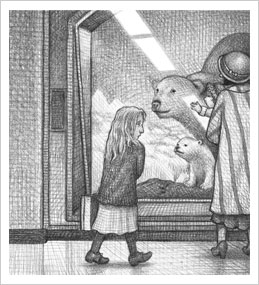Painting Diorama Backgrounds
By Sean Murtha

The word “diorama” means “to look through” in Greek, and originally applied to theatrical displays and popular entertainments in the 1820’s. When museums began to incorporate these ideas into exhibits in the late 1800’s, they often used other terms such as “Habitat Group”, but “diorama” is still the term by which they are best known. Though still popular today, the true “golden age” of the diorama, when they reached their highest level of achievement, was from about 1900 to the 1940’s.
The American Museum of Natural History (AMNH) in New York City was a pioneer in diorama creation and set a high standard for realism, scientific accuracy, and artistry. To insure accuracy, teams of artists and scientists would travel to specific locations to collect foreground materials and paint studies of the scenery. Back at the museum, sculptors would create artificial plants, trees and rocks from plaster casts brought back from the field, taxidermists would sculpt animal forms upon which real skins would be attached, and painters would create large background murals to replicate the view from the actual site.
When I began working at the AMNH in the 1990’s, dioramas had fallen out of use. In fact, at my job interview, when I was asked what I would most like to do and my answer was “paint diorama backgrounds!”, the response was that they “didn’t do those anymore, though there are still interesting things to do.” As indeed there were; my first project was sculpting prehistoric trees for an exhibit on amber, and it was so successful that for the next exhibit I was asked to do a full-blown diorama, with a background painting! This eventually led to my painting over a dozen dioramas, many in the Milstein Hall of Ocean Life.
I learned quickly that it was not simply a matter of painting large. In the best diorama backgrounds, the viewer forgets they are looking at a painting. This is achieved by a combination of keeping the surface smooth, lighting it evenly, and carefully controlling the perspective. Because the background is curved, from side to side and often from bottom to top, the painter has to change the sizes of things, and sometimes the shapes, in order for them to look right from the front. Objects along the edges of the background, where the wall is turning towards the viewer, are often stretched out, something like the way letters painted on the road near school crossings are stretched so they can be read easily by approaching drivers. Another very important part of the illusion is the area where the painting meets the sculpted foreground, what is called the “tie-in”. Here the artist must carefully paint grasses, stones, and other objects to perfectly match the 3-dimensional objects just in front of them. When done well, it can be very difficult to know where the foreground ends and the background begins, and this helps create the illusion that the space inside the diorama is far larger than it actually is.
I had been an artist since childhood, and pursued an art degree at Pratt Institute in Brooklyn, NY. My favorite subjects have always been landscapes and birds, painted in a realistic style. I was well suited to the needs of diorama backgrounds, but the unique methods required for painting them are taught nowhere but at museums such as the AMNH, which has maintained a staff of artists throughout its history. Because dioramas had not been done on a large scale for many years, there were few people left who knew all of these techniques. I was very fortunate to work under the direction of Steve Quinn, who had made a point of learning from the last artists from the “golden age” before they had retired. I also visited one of those retired artists myself, Fred Scherer, who is still painting well into his 90’s, and taught me many of the secrets he had learned from the master of diorama painters, James Perry Wilson. Another of Wilson’s students, Ruth Morrill, has also helped me along, even joining me in laying out the perspective drawing for one of my dioramas.
James Perry Wilson was the artist who actually painted the Wolf diorama which is featured in “Wonderstruck”. It was done in 1945, not 1965 as in the story, though its setting is indeed at Gunflint Lake, Minnesota. Though Brian Selznick has fictionalized the creation of this marvelous diorama, he has accurately captured the dreamlike quality such a diorama has to transport a viewer to another place and time, and to capture a moment so magically that it evokes the same feeling as an actual encounter in nature.
Sean Murtha is an artist specializing in landscapes, bird painting and museum exhibits. From 1996 to 2007 he worked at the American Museum of Natural History, where he learned the unique skills required for diorama background painting and completed over a dozen dioramas, many in the Milstein Hall of Ocean Life. He currently works in the Exhibition department of the Bruce Museum of Art and Science in Greenwich CT and continues to create dioramas on a freelance basis. His dioramas and easel paintings can be seen at www.seanmurthaart.com